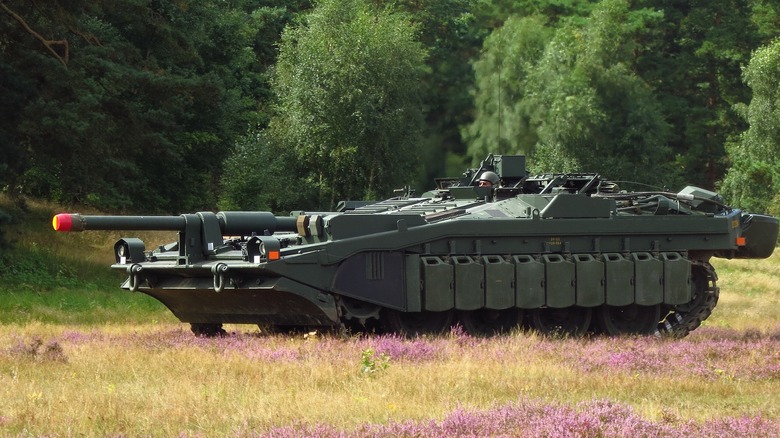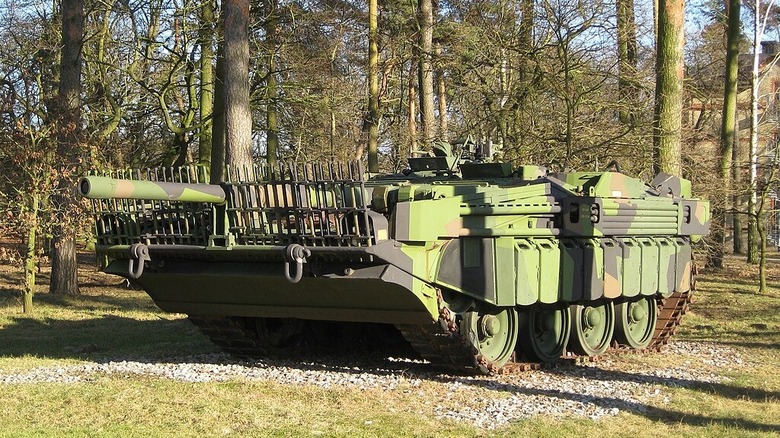What Makes Sweden's Stridsvagn 103 Tank Such An Oddball
Sweden has officially been a neutral country since the days of King Gustav XIV in 1834. But its non-alignment stance stretches back even further to 1812, amidst the backdrop of the Napoleonic Wars. For over 200 years, it has maintained that neutrality through every global conflict and world war.
However, not long after Russia invaded Ukraine in early 2022, both Sweden and Finland applied for NATO membership. Not because they wanted to but because they felt threatened enough by Putin's warlike actions. That's not to say Sweden is without a strong military — quite the contrary.
During the Cold War, Sweden was caught between the proverbial rock and a hard place. Military strategy was precarious. With being neutral, Sweden had to walk a tightrope by showing it was strong enough to defend itself but not powerful enough to invade.
Part of that strategy involved the creation of the Stridsvagn 103 (or "S-Tank"), an armored fighting vehicle (AFV) with good defense but almost no offensive firepower. The number 103 stands for Sweden's 3rd tank armed with a 10 cm main gun, while Stridsvagn in English literally means "battle wagon." In all respects, this battle wagon fulfilled the Goldilocks principle of being "just right" for the occasion. When the Swedish army rolled it into service in 1967, it was simultaneously one of the weirdest and most revolutionary tanks ever built.
[Featured image by Jorchr via Wikimedia Commons | Cropped and scaled | CC BY-SA 3.0]
The tank that wasn't a tank?
The wholly unconventional Stridsvagn was packed with innovations. It was the first production AFV powered by a turbine engine (two, in fact) and the only one made since WW2 that didn't have a turret. Without it, the S-Tank looked non-threatening, almost weak.
Some quibble that it shouldn't even be classified as a tank because it doesn't have a turret, but the low-profile design allowed it to hunker down and remain hidden until it could ambush an invader. To defend the country, of course.
The 103 was fitted with an autoloading Bofors 105mm L/62 main gun fixed inside the hull. It's the same gun found in the U.S. military's legendary Abrams tanks and fires the same rounds as the British 105 mm L7. Since spent shells were also autoejected through a flap out the back, this unique setup allowed the Stridsvagn to be operated by only two crew members. While the driver also acted as the gunner, a second crew member worked the radio and could drive the tank in reverse when needed. This kept the more heavily armored front facing the enemy.
Two engines initially powered the 103 and were mated to a fully automatic transmission. The first engine was a 240 hp Rolls-Royce K60 opposed-piston diesel used for slow maneuvers in combat, while the second — a 300 hp Boeing 502 turbine – was used for speed. The Boeing was eventually replaced with a 490 hp Caterpillar turbine, which boosted the tank's horsepower to over 700 and reached a top speed of 31 mph.
The Stridsvagn had all the bells and whistles, but ...
Sweden's defensive tank had a hydropneumatic suspension that could lower the hull by another five inches if needed. This not only provided a smooth ride over rough terrain but also gave it a 22-degree field of fire that was better than most other tanks.
The 40-ton tank was fitted with a float screen system that could be inflated to make it amphibious in approximately 25 minutes. Apart from its almost 4-inch thick armor plating, additional slat armor could be attached to the front to keep HEAT rounds from striking the hull. Adding nine jerry cans along the sides gave it more buoyancy during amphibious actions and acted as additional protection.
It could push boulders, trees, and other minor obstacles out of its way. If it couldn't get into a defensive position by clambering into a natural ditch amidst the frozen tundra of Sweden, the Stridsvagn could make one using the dozer blade mounted under the nose. When tilted forward, it could be used exactly like an earth-moving bulldozer and, when folded back, acted as another layer of armor.
Despite all the tech goodness, this oddball tank couldn't fire while moving. It literally had to first come to a complete stop. Again, it was part of a neutral, defense-first nation and couldn't be too aggressive. A total of 290 Stridsvagns were produced, with the last iteration retiring from service in 1997. It was never battle-tested.
[Image by Jorchr via Wikimedia Commons | Cropped and scaled | CC BY-SA 3.0]

